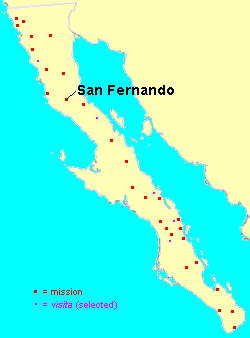
Misión San Fernando Rey de España de Velicatá
Encyclopedia

Baja California
Baja California officially Estado Libre y Soberano de Baja California is one of the 31 states which, with the Federal District, comprise the 32 Federal Entities of Mexico. It is both the northernmost and westernmost state of Mexico. Before becoming a state in 1953, the area was known as the North...
, Mexico
Mexico
The United Mexican States , commonly known as Mexico , is a federal constitutional republic in North America. It is bordered on the north by the United States; on the south and west by the Pacific Ocean; on the southeast by Guatemala, Belize, and the Caribbean Sea; and on the east by the Gulf of...
about 200 miles south of Ensenada
Ensenada, Baja California
Ensenada is a coastal city in Mexico and the third-largest city in Baja California. It is located south of San Diego on the Baja California Peninsula. The city is locally referred to as La Cenicienta del Pacífico, or, The Cinderella of the Pacific...
, Misión San Fernando Rey de España de Velicatá was the only mission founded by Franciscans in Baja California.
The site for the future mission was identified by the Jesuit
Society of Jesus
The Society of Jesus is a Catholic male religious order that follows the teachings of the Catholic Church. The members are called Jesuits, and are also known colloquially as "God's Army" and as "The Company," these being references to founder Ignatius of Loyola's military background and a...
missionary-explorer Wenceslaus Linck
Wenceslaus Linck
Wenceslaus Linck was the last of the outstanding Jesuit missionary-explorers in Baja California.Born in Bohemia , he entered the Jesuit order at age 18 and studied at Brno and Prague. In New Spain, he continued his studies in Mexico City and Puebla between 1756 and 1761...
in 1766. After the Jesuits were replaced by the Franciscans in 1768, the latter were charged with extending Spanish control far to the north, into Alta California
California
California is a state located on the West Coast of the United States. It is by far the most populous U.S. state, and the third-largest by land area...
in 1769. Mission San Fernando, at the Cochimí
Cochimi
The Cochimí are the aboriginal inhabitants of the central part of the Baja California peninsula, from El Rosario in the north to San Javier in the south....
settlement of Velicatá on the route north, was inaugurated by Junípero Serra
Junípero Serra
Blessed Junípero Serra, O.F.M., , known as Fra Juníper Serra in Catalan, his mother tongue was a Majorcan Franciscan friar who founded the mission chain in Alta California of the Las Californias Province in New Spain—present day California, United States. Fr...
.
In the 1770s, under the Franciscans and then after 1773 under their Dominican
Dominican Order
The Order of Preachers , after the 15th century more commonly known as the Dominican Order or Dominicans, is a Catholic religious order founded by Saint Dominic and approved by Pope Honorius III on 22 December 1216 in France...
successors, the mission quickly reached its peak and went into decline as epidemics decimated the native population. A missionary was no longer permanently resident at the site after about 1818. A few ruined walls and stone foundations survive at the site as well as petroglyphs and some remains of pictograms.
External links
- http://www.hotel-calafia.com/History-Missions.jsp
- http://www.bajacalifologia.org/english/history.htm
- bajamissions The Spanish missions and visitas of Baja California.

